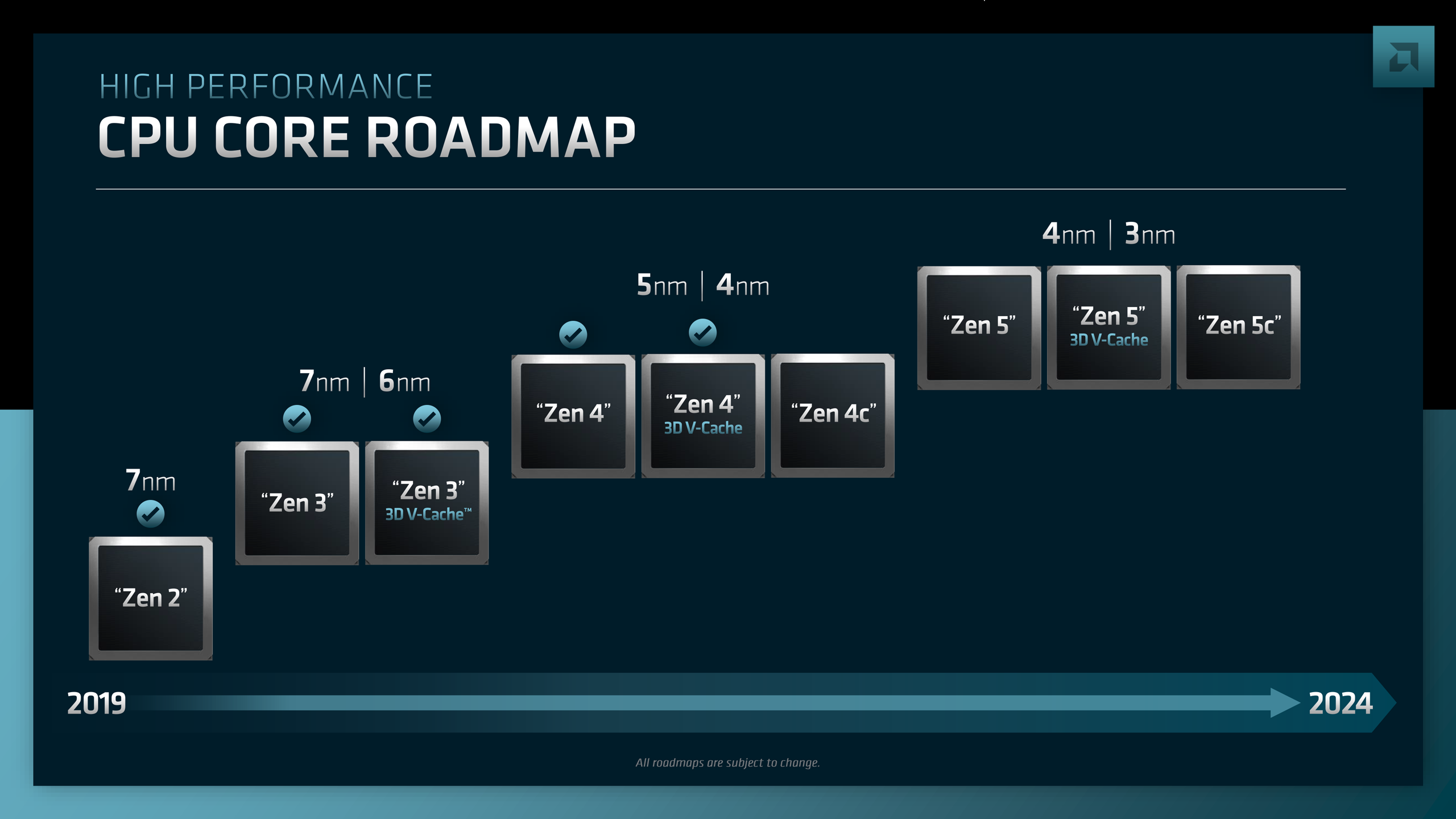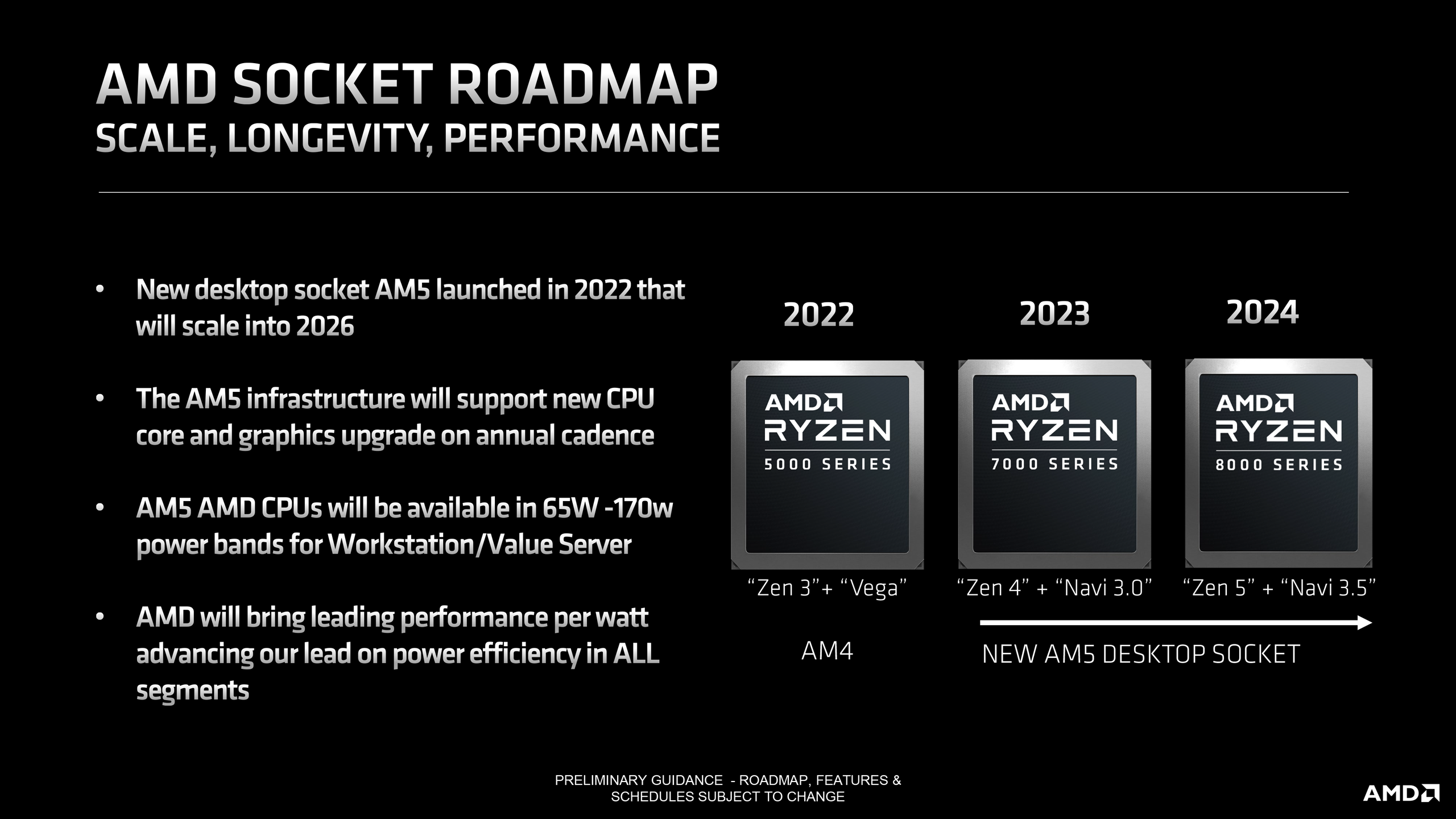AMD Begins Zen 5 Prep, Sends First Linux Patches

AMD has begun to enable its next-generation Family 1Ah, or Family 26 processors, presumably based on the Zen 5 microarchitecture, in Linux. The patch submissions come in preparation for a commercial launch in the coming quarters, reports Phoronix. The initial patches reveal some of the first details about AMD's server CPUs based on the next-generation microarchitecture.
The first three patches sent on Thursday add new PCI IDs for AMD's Family 26 (1Ah) processors models 00 to 31 and 64 to 79 (00h – 1Fh and 40h – 4Fh), thermal sensor support to the k10temp driver, and the EDAC AMD64 driver for memory error detection and correction.
The EDAC driver for AMD's Family 26 processors reveals that they will have a maximum of 12 memory channels, which is in line with the number supported by AMD's Genoa and Bergamo CPUs. Meanwhile, we have no idea whether Zen 5-based processors will keep using AMD's existing server platform, or if they will adopt a new one. Meanwhile, keeping in mind the upcoming memory module standards like MR-DIMMs and MCR-DIMMs that will need support on the platform level, we would expect AMD's next-generation server platform to have some differences compared to the current generation.
While the new patches hardly reveal many details about AMD's upcoming Ryzen and EPYC processors based on the Zen 5 microarchitecture, the very fact that AMD began to enable these CPUs in Linux indicates that the company is getting ready to test and then launch them commercially.
AMD has officially revealed that it's Zen 5-based processors will belong to the Ryzen 8000 series and will be released in 2024. The desktop versions of these Zen 5-powered CPUs in AM5 packaging have purportedly been internally labeled as Granite Ridge, while the laptop variants are referred to as Strix Point. These upcoming CPUs are thought to use Navi 3.5-based integrated GPUs.
Get Tom's Hardware's best news and in-depth reviews, straight to your inbox.

Anton Shilov is a contributing writer at Tom’s Hardware. Over the past couple of decades, he has covered everything from CPUs and GPUs to supercomputers and from modern process technologies and latest fab tools to high-tech industry trends.
-
gg83 Is this a true statement from the slide? " AMD will bring leading performance per watt advancing our LEAD on power efficiency in ALL segments"Reply -
digitalgriffin Reply
As it stands now, AMD does have the most power efficient architectures. Intel is faster only based on using a ton more energy. This make AMD a better choice for laptops.gg83 said:Is this a true statement from the slide? " AMD will bring leading performance per watt advancing our LEAD on power efficiency in ALL segments"
I have a 12th gen Lenovo laptop for work. That thing puts out so puts out so much heat that I use it to keep my coffee warm. I kid you not. I keep the mug in the exhaust airstream. I don't even keep it maxed out for compiles that often. This is mostly typing.
Not to be dramatic about it, but a number of coworkers Lenovo's laptops are failing. They aren't that old. I'm wondering if it is heat related. -
Rico Ismail Reply
TSMC 7nm wafer cost $10.000 USDAdmin said:AMD's 'Family 26' CPUs for servers will continue to feature a 12-channel memory subsystem.
AMD Begins Zen 5 Prep, Sends First Linux Patches : Read more
TSMC 5nm wafer cost $16.000 USD but with 1.8x transistor density
so making 7nm IOD is useless since 5nm wafer is 1.6x more expensive but you get 1.8x more transistor, it mean reduced price per transistor, or you get more transistor with same price, or lower cost with same transistor count. Also you get benefit of smaller area, higher clock speed, and reduced power consumption. Also $20.000 USD 3nm have 1.25 more cost but 1.3x more transistor density.
IOD can only support DDR5 6400 of max EXPO supposted. DDR5 7200 and 7600 are on market now. DDR 5 7800 and 8000 on going. I hope next gen AMD EXPO will support it. Also 1.3v SOC capasitor is easy to burn since many enthusiast will overclock the memory.
And making large 32MB L3 cache in 5nm CCD is wasting money since only 1.2x sram area reduction but 1.6x cost than 7nm. fitting 64MB 7nm 3D v-cache as L3 cache on top of cooler area CCD's L2 chace is a good idea.
Also two piece for X3D model (128MB of total or more with infinity cache). Or place L3 on infinity cache will boost clockspeed due to lower sram temps. I think replace AVX512 instruction with AI engine or neural engine will be cool to meet AI demand.
And Also remove IHS will reduce core temps by 10 degree. Or make thickness IHS or more thermal conductive IHS.
5nm IOD with DDR5 7600++ expo support and 1.5v SOC caps + tsmc N4X CCD (16 core per CCD) with AI + 64MB 7nm 3D L3 V-cache (+64MB more infinity cache or one more stacked cache for X3D model) + remove IHS / copper thick IHS will be better next gen Ryzen -
dotjaz ReplyRico Ismail said:TSMC 7nm wafer cost $10.000 USD
TSMC 5nm wafer cost $16.000 USD but with 1.8x transistor density
so making 7nm IOD is useless since 5nm wafer is 1.6x more expensive but you get 1.8x more transistor, it mean reduced price per transistor, or you get more transistor with same
Looks like someone didn't get the memo. 1.8x logic transistor density, SRAM is only 1.2-1.3x, analog I/O is nearly 1x.
Wanna guess what vast majority of I/O Die's transistors are?
And making large 32MB L3 cache in 5nm CCD is wasting money since only 1.2x sram area reduction but 1.6x cost than 7nm.
What kind of idiot claims 5nm SRAM is a waste of money because of poor scaling but 5nm IOD is excellent because of EVEN WORSE SCALING?
SRAM in CCD at least gets better frequency, latency and voltage tolerance.
Keyboard warriors always know more than corporations who's main goal is profit. And when corporations claim it costs less, Keyboard Warriors always prove them wrong. Nice. -
TerryLaze Reply
You are talking about a ton more energy so you must be talking about the high end.digitalgriffin said:As it stands now, AMD does have the most power efficient architectures. Intel is faster only based on using a ton more energy.
Higher is better, so intel is about 40% more energy efficient even with power limits removed, the thing that makes the whole intel CPU less efficient are the e-cores and the fact that everybody (reviewers) overclocks the intel CPUs to oblivion.
As you can see the overclocked 13900k is the lowest on the list.
Yes the 7600x is the most efficient one on the list but, just with the overclocked 13900, if you want to make it run faster, closer to the speed of the 7950x ,it will be much less efficient.
https://www.techpowerup.com/review/intel-core-i9-13900k/22.html -
gruffi Reply
LOL. No. Many reviewers test with stock settings. The e-cores are somewhat less power efficient than the p-cores. That's true. But only at the same clock speed. No one really cares about power efficiency of a single thread in a certain application. Especially not where it matters, e.g. the professional market. Single thread also is more affected by several factors.TerryLaze said:Higher is better, so intel is about 40% more energy efficient even with power limits removed, the thing that makes the whole intel CPU less efficient are the e-cores and the fact that everybody (reviewers) overclocks the intel CPUs to oblivion.
Intel isn't even close in power efficiency when it comes to the whole processor design. The problem is, not only Intel but now also AMD increased the power target a lot. Which means both get quite inefficient with their top SKUs. You have to compare at lower power targets to see the real deficit of Intel.
Performance of 13900K drops a lot at lower power targets. 7950X is much less prone to lower power targets. It performs almost the same at about half the stock power. It scores over 50% more points at 35W than 13900K in that benchmark. That's why AMD is so far ahead of Intel right now. Especially in professional markets where they benefit more from this advantage. -
digitalgriffin Reply
Cherry picking data to defend your precious Intel again I see.TerryLaze said:You are talking about a ton more energy so you must be talking about the high end.
Higher is better, so intel is about 40% more energy efficient even with power limits removed, the thing that makes the whole intel CPU less efficient are the e-cores and the fact that everybody (reviewers) overclocks the intel CPUs to oblivion.
As you can see the overclocked 13900k is the lowest on the list.
Yes the 7600x is the most efficient one on the list but, just with the overclocked 13900, if you want to make it run faster, closer to the speed of the 7950x ,it will be much less efficient.
https://www.techpowerup.com/review/intel-core-i9-13900k/22.html
Color me shocked.
I am really confused by you sometimes. You cherry pick data to make your argument. Then it's easily disprovable by looking at the whole picture from various review sites. And all you do is just kind of get people to prove Intel is trailing.
If you want the fastest Intel is the way to go. But you pay for it multiple ways. -
TerryLaze Reply
AMD is cheating at stating their power draw that's why.gruffi said:Performance of 13900K drops a lot at lower power targets. 7950X is much less prone to lower power targets. It performs almost the same at about half the stock power. It scores over 50% more points at 35W than 13900K in that benchmark. That's why AMD is so far ahead of Intel right now. Especially in professional markets where they benefit more from this advantage.
Both are off from the real numbers but AMD is much farther from their stated numbers.
https://www.anandtech.com/show/17641/lighter-touch-cpu-power-scaling-13900k-7950x/3If you lock both CPUs to the same power so that they can't go above that then ryzen is 13% more efficient as a whole system at full default power (230 - 253) but also at 140W.
At 45W the 13900k is 9% more efficient...
AMD states the TDP instead of the PPT so most reviewers just post the TDP number AMD gives them instead of actual numbers.
https://www.computerbase.de/2022-10/intel-core-i9-13900k-i7-13700-i5-13600k-test/4/#abschnitt_leistung_in_multicorelasten_klassisch
-
TerryLaze Reply
How is that cherry picking in your mind?digitalgriffin said:Cherry picking data to defend your precious Intel again I see.
Color me shocked.
I am really confused by you sometimes. You cherry pick data to make your argument. Then it's easily disprovable by looking at the whole picture from various review sites. And all you do is just kind of get people to prove Intel is trailing.
If you want the fastest Intel is the way to go. But you pay for it multiple ways.
Anything else you do will mix performance from different cores and smt together with the main cores which will give you an overall result and won't tell you anything about the thing you want to know about.
